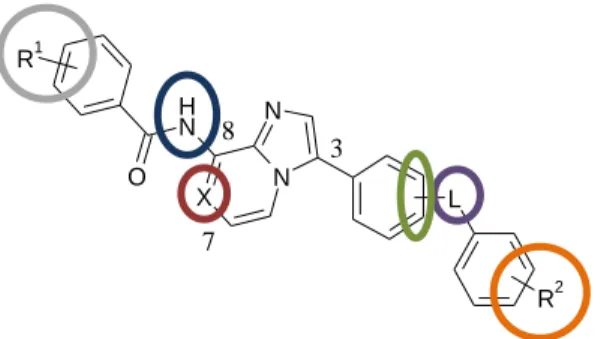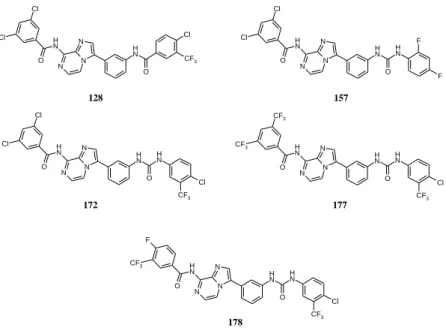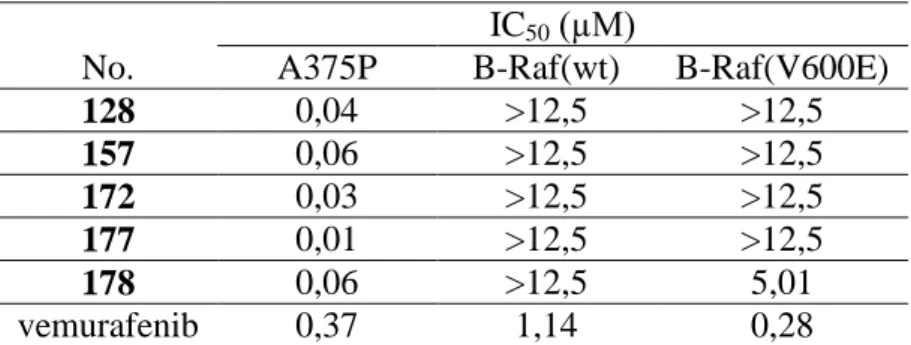Design, synthesis and biological evaluation of novel compounds against melanoma
PhD thesis
Rita Garamvölgyi
Semmelweis University
School of Pharmaceutical Sciences
Supervisor: László Őrfi, Ph.D., associate professor
Official reviewers: András Hrabák, Ph.D., associate professor Gábor Dibó, C.Sc., associate professor Head of the Theoretical Exam Committee:
Éva Szökő, D.Sc., professor
Members of the Theoretical Exam Committee:
György Dombi, D.Sc., professor
Gábor Krajsovszky, Ph.D., associate professor
Budapest
2016
1. INTRODUCTION
Cancer is a collective term for diseases, that share common characteristics, like abnormal cell division, spreading to adjacent tissues or to distants parts of the body. During the formation of tumours due to external and/or internal factors mutations occur in the body, which can influence the function of molecules involved in cell cycle control, therefore leading to uncontrolled cell proliferation by disrupting the regulation of cell division.
Tumorous diseases are among the leading causes of death in Hungary, like in the world’s developed and developing countries. The incidence of cancer shows an increasing tendency worldwide, which can be attributed to the growth and aging of the world’s population as well as the spread of known risk factors, such as smoking, obesity and lack of physical activity.
It is particularly important to explore the underlying cellular processes and the external/internal risk factors contributing to tumour formation in order to effectively prevent the development of the disease and to design new drugs that can inhibit the growth and spread of tumours.
1.1. Melanoma
Melanoma is a malignant tumour that arises from the melanocytes of the skin. Melanocytes localize within the basal layer of the epidermis and their main role is the protection of the skin against UV radiation. Ultraviolet radiation facilitates the malignant transformation in the skin by increasing the production of growth hormones, suppressing the immune responses responsible for skin protection and elevating the amount of DNS damaging reactive oxigen species. As a result of the antiapoptotic effect of the reactive oxigen species the affected melanocyte does not die, thus becomes exposed to additional DNS damage, which can eventually lead to malignant transformation.
Development of melanoma is influenced by genetic and environmental risk factors. The best-known environmental risk factor, that plays a role in the formation of melanoma is UV radiation. The most important individual attributes that determine melanoma susceptibility are phenotype, presence of multiple benign, atypical naevi, family history of melanoma, previous occurrence of melanoma, immunosuppression and the use of tanning beds.
The incidence of melanoma has been increasing worldwide, with approximately 200,000 new cases being diagnosed annually.
1.2. Current therapies
The prognosis of the patients mainly depends on how advanced the disease is at the time of the diagnosis. While the 5-year survival rate is 98.3% for patients with localized melanoma, it dramatically decreases for patients with regional-stage (62.4%) and distant-stage disease (16.0%).
Until the mid 1970s surgery provided the only therapeutic option for patients with melanoma. By the approval of dacarbazine (1975) and high-dose interleukin-2 (1998) the systemic treatment of metastatic melanoma became possible.
However, less than 20% of patients show measurable therapeutic response to these treatments.
Discovery of the molecular mechanisms behind melanoma has led to the development of novel targeted therapies. The MAPK (Ras-Raf-MEK-ERK) pathway became an important target, being the most commonly affected pathway in melanoma. The approval of vemurafenib (PLX4032) in 2011 is considered to be a milestone in the treatment of melanoma,
since it is the first targeted drug, that can selectively inhibit the mutant B-Raf kinase. In 2013 an additional B-Raf inhibitor, called dabrafenib (GSK2118436), gained approval.
Trametinib (GSK1120212) is the first selective MEK kinase inhibitor, that has been approved for the treatment of metastatic melanoma.
Besides targeted therapies a new treatment approach has emerged by the discovery of immunotherapy. The antibodies targeting CTLA-4 and PD-1 (ipilimumab, pembrolizumab, nivolumab) can increase antitumour immune responses by the activation of T cells.
2. OBJECTIVES
In the course my PhD research I planned to synthesize imidazo[1,2-a]pyridine and imidazo[1,2-a]pyrazine based diarylamide and diarylurea derivatives (Figure 1.). The relatively small number of literary examples in this compound family rationalized our aim to further study these compounds, with special emphasis on their antitumour activity.
X N NH N R1
NH R2 O R1 = H, ArCO R2 = Ar, ArNH X = C, N
Figure 1. General structure of the synthesized imidazo[1,2-a]pyridine and imidazo[1,2-a]pyrazine derivatives.
I aimed to:
develop appropriate synthetic routes for the synthesis of the designed analogues,
characterize the synthesized compounds,
synthesize a literary reference compound in order to compare the biological activities,
evaluate the antiproliferative activity of the synthesized compounds on the A375P melanoma cell line,
carry out structure-activity relationship studies based on the antitumour activity on melanoma cells,
determine the kinase inhibitory activity of the compounds on B-Raf(wt) and B-Raf(V600E) kinases,
determine the antiproliferative activity of the selected compounds on lung and colon tumour cell lines.
3. MATERIALS AND METHODS 3.1. Synthetic procedures
The synthetic route developed for the synthesis of the meta substituted imidazo[1,2-a]pyridine derivatives is outlined in Figure 2.
N N H O
N N H
O
N N H O
N N H
N H
O N NH O
N NH2 N
NH O
N Br N
NH O
N N
N H2
N N
N H2
NH2
R1 R1 R1
R1 R1
R2
R2
a b c d
e
f
1 2 3-8 15-20
21-51 52-71
9-14
Figure 2. Synthesis of the meta substituted imidazo[1,2-a]pyridine derivatives. Reagents and conditions: (a) 50% aq. chloroacetaldehyde, EtOH, reflux, 3.5 h, 58%; (b) benzoic acid, EDCI, pyridine, 40 °C, 4 h, 36-86%; (c) N-bromosuccinimide, CH2Cl2, 25 °C, 30 min, 69-94%; (d) (3- aminophenyl)boronic acid, Pd(PPh3)4, Na2CO3, 1,4-dioxane, H2O, microwave reactor, 140 °C, 1.5 h, 27-69%; (e) benzoic acid derivative, EDCI, pyridine, 70 °C, 2 h, 52-84%; (f) aryl isocyanate, anhydrous pyridine, 25 °C, 2 h, 56-90%.
The synthesis of the para substituted imidazo[1,2-a]pyridine derivatives is shown in Figure 3.
N NH O
N
N H O
N NH O
N
NH N H O N
NH O
N
NH2 N
NH O
N
Br R2
R2
9 72
73-78
79-80 a
b
c
Figure 3. Synthesis of the para substituted imidazo[1,2-a]pyridine derivatives. Reagents and conditions: (a) 4-(4,4,5,5-tetramethyl-1,3,2- dioxaborolan-2-yl)aniline, Pd(PPh3)4, Na2CO3, 1,4-dioxane, H2O, microwave reactor, 140 °C, 2 h, 36%; (b) benzoic acid derivative, EDCI, pyridine, 70 °C, 2 h, 45-73%; (c) aryl isocyanate, anhydrous pyridine, 25
°C, 2 h, 40-58%.
Analogous approach to the previously described synthetic sequence could not be used for the preparation of the imidazo[1,2-a]pyrazine derivatives. Therefore these compounds were synthesized according to the route depicted in Figure 4.
N N NH O
N NH
O R2 R1
N N NH O
N NH
O NH R1
R2 N N
N H2
N NH
O NH R2 N N
N H2
N NH
O R2
N N N H2 N
NH2 N N
N H2 N
Br N N
Cl N Br N N
Cl N N N
Cl NH2
a b c d
e
f
g
h
81 82
86-107
108-140
141-152
153-178
83 84 85
Figure 4. Synthesis of the imidazo[1,2-a]pyrazine derivatives. Reagents and conditions: (a) Bromoacetaldehyde diethyl acetal, 48% aq. HBr solution, reflux, 1.5 h, NaHCO3/IPA, then 81, reflux, 3 h, 73%; (b) N- bromosuccinimide, CH2Cl2, 25 °C, 3 h, 93%; (c) 25% aq. NH4OH solution, IPA, microwave reactor, 120 °C, 3 h, 85%; (d) (3- aminophenyl)boronic acid, Pd(PPh3)4, Na2CO3, 1,4-dioxane, H2O, microwave reactor, 140 °C, 1.5 h, 75%; (e) benzoic acid derivative, EDCI, pyridine, 40 °C, overnight, 35-70%; (f) benzoic acid derivative, EDCI, pyridine, 70 °C, 6 h, 11-81%; (g) aryl isocyanate, anhydrous pyridine, 25
°C, 2 h, 20-69%; (h) benzoic acid derivative, EDCI, pyridine, 70 °C, 6 h, 10-64%.
Compound 181 could not be synthesized via the previously presented synthetic routes. Thus it was prepared according to Figure 5.
N N N H2
N N+ O N O
N N H2 N
Br N
N NH O
N N+ O O CF3
CF3
N N NH O
N NH2 CF3
CF3
84
a b c
179 180 181
Figure 5. Synthesis of N-[3-(3-aminophenyl)imidazo[1,2-a]pyrazine-8- yl]-3,5-bis(trifluoromethyl)benzamide (181). Reagents and conditions: (a) (3-nitrophenyl)boronic acid, Pd(PPh3)4, Na2CO3, 1,4-dioxane, H2O, microwave reactor, 140 °C, 1.5 h, 57%; (b) 3,5-bis(trifluoromethyl)- benzoic acid, EDCI, pyridine, 70 °C, 2 h, 36%; (c) H-Cube®, column: 10%
Pd/C, eluent: ethanol/ethyl acetate, 25 °C, 12%.
The imidazo[1,2-a]pyrazine derivative (183, Figure 6.), known from the literature, can be considered as the closest structural analogue of the designed compounds. Thus it was important to synthesize it in order to compare the biological activities.
N N NH O
N
NH O CF3
CF3
N N N H2
N
NH2
N N N H2
N Br
84
a b
182 183
Figure 6. Synthesis of the known imidazo[1,2-a]pyrazine derivative (183).
Reagents and conditions: (a) 4-(4,4,5,5-tetramethyl-1,3,2-dioxaborolan-2- yl)aniline, Pd(PPh3)4, Na2CO3, 1,4-dioxane, H2O, microwave reactor, 140
°C, 1.5 h, 72%; (b) 4-(trifluoromethyl)benzoic acid, EDCI, pyridine, 70
°C, 4 h, 75%.
3.2. Biological evaluation
The antiproliferative activity of the prepared compounds was evaluated on the BRAF(V600E) mutant A375P human malignant melanoma cell line. The reliability of the measurements was validated in all cases by using reference compounds (sorafenib, vemurafenib). The PRIMES and Lungtarget grants funded by the European Union allowed us to evaluate the activity of the selected compounds on different lung and colon tumour cell lines. With these measurement we intended to determine whether the strong antitumour activity observed on the melanoma cell line also manifests on cell lines with different origin and genetic background.
In the case of our most potent compounds, we carried out further experiments in order to investigate their mechanism of action. The abnormal proliferation of the A375P cells may be driven by the mutation of the BRAF gene, therefore the kinase inhibitory activity of the prepared derivatives was determined on the wild-type and V600E mutant B-Raf kinases.
Vemurafenib, a known B-Raf inhibitor was used as a reference compound.
4. RESULTS
By developing the appropriate synthetic routes I managed to synthesize the planned derivatives in 5-6 steps from commercially available reagents. Besides a known reference compound I synthesized 59 imidazo[1,2-a]pyridine and 94 imidazo[1,2-a]pyrazine derivatives.
The in vitro antiproliferative activity of the compounds was measured on the A375P human malignant melanoma cell line.
The figure below illustrates the chemical modifications, that were applied in order to explore the structure-activity relationships of this compound family.
Figure 7. General structure of the prepared derivatives.
X N NH O
N
L
R2 R1
3
7 8
The examined chemical modifications were the following (Figure 7. from left to right):
the substituent(s) of the benzoyl group (R1),
the substitution of the amino group, that connects to position 8 of the core,
the presence of carbon or nitrogen in the 7th position of the core,
the meta or para position of the linker moiety on the benzene ring, that connects to the 3rd position of the core,
the linker (L) moiety (amide or urea),
the substituent(s) of the benzene ring connecting to the linker (R2).
N N NH O
N
NH O
NH Cl CF3
Cl Cl
N N NH O
N
NH O
NH Cl
Cl
F
F
N N NH O
N
NH O
NH Cl CF3
CF3
CF3 N N
NH O
N
NH O Cl
Cl
Cl CF3
N N NH O
N
NH O
NH Cl CF3
CF3
F
128 157
172 177
178
Figure 8. Structures of the most active compounds (128, 157, 172, 177, 178).
The applied chemical modifications allowed us to explore, which structural elements have crucial role in the efficacy.
From the prepared derivatives, compounds 128, 157, 172, 177 and 178 showed the strongest antiproliferative activity with IC50 values below 0.06 µM (Figure 8.)
The development of melanoma is often associated with the abnormal functioning of the B-Raf protein. Therefore, we determined the kinase inhibitory activity of our most potent
molecules on B-Raf(wt) and B-Raf(V600E) proteins (Table 1.)
Table 1. The antiproliferative activity of the selected compounds on the A375P melanoma cell line and the kinase inhibitory activity on B-Raf(wt)
and B-Raf(V600E) kinases.
IC50 (µM)
No. A375P B-Raf(wt) B-Raf(V600E)
128 0,04 >12,5 >12,5
157 0,06 >12,5 >12,5
172 0,03 >12,5 >12,5
177 0,01 >12,5 >12,5
178 0,06 >12,5 5,01
vemurafenib 0,37 1,14 0,28
We had the opportunity to investigate the antiproliferative activity of the most promising compounds on different lung (A549, H358, PC9, PC9-ER) and colon tumour (HCT116, HKE3) cell lines. The results are summarized in Table 2.
Table 2. The antiproliferative activity of the selected compounds on lung and colon carcinoma cell lines.
IC50 (µM) No. A549 H358 PC9 PC9-
ER
HCT
116 HKE3 128 3,23 4,21 3,61 3,63 1,81 0,83 157 2,61 4,17 2,77 2,56 0,88 0,62 172 8,44 8,58 11,58 8,01 9,51 10,02 177 10,43 7,55 11,57 14,62 5,31 6,35
5. CONCLUSIONS
Based on the IC50 values measured on the A375P human melanoma cell line, the following conclusions can be drawn about the structure-activity relationships of the synthesized compounds.
In the case of the imidazo[1,2-a]pyridine derivatives it can be inferred, that:
the R2 substituent plays an important role in the efficacy,
generally the diarylurea derivatives showed more potent antiproliferative activity, than the diarylamide analogues,
alteration of the R1 substituent affected the biological activity of the diarylamide derivatives, while it had no effect in the case of the diarylurea derivatives,
changing the position of the linker moiety (meta to para) on the phenyl ring, that connects to the 3rd position of the imidazo[1,2-a]pyridine core can either be beneficial, detrimental or neutral in terms of the activity.
In the case of the imidazo[1,2-a]pyrazine derivatives it can be inferred, that:
the presence of the linker (L) and the connecting substituted phenyl ring is indispensible for the activity,
using the proper R2 substituent is important for the activity,
the presence of the substituted benzoyl group on the nitrogen, connecting to the 8th position of the imidazo[1,2- a]pyrazine scaffold, is not essential for the antiproliferative activity, but it can greatly modify it,
considering the R1 substituents of the benzoyl group, the most potent compounds bear 3,5-dichloro- or 3,5- bis(trifluoromethyl) moieties,
regarding the choice of the linker no clear conclusions can be drawn. There are compounds both from the amide and urea series, that show outstanding activity.
By comparing the corresponding imidazo[1,2-a]pyridine and imidazo[1,2-a]pyrazine derivatives it can be inferred, that the nitrogen in the 7th position of the scaffold has a crucial role in the biological activity.
Among the prepared derivatives, compounds 128, 157, 172, 177 and 178 showed the strongest antiproliferative activity, with IC50 of 0.04 µM, 0.06 µM, 0.03 µM, 0.01 µM and 0.06 µM, respectively.
The best compounds expressed superior activity compared to both the closest structural analogue described in the literature (183) and to vemurafenib, a currently used therapy against melanoma.
The mechanism of action of this compound family has not been clarified yet. Although, according to the in vitro biochemical assay results, these molecules do not exert the observed antiproliferative effect via the inhibition of the B- Raf kinase.
We discovered, by carrying out experiments on cell lines having different origin and genetic background, that the compounds can selectively inhibit the proliferation of the melanoma cells from the tested 7 cell lines. Therefore it can be assumed, that these compounds do not act as general cytotoxic agents.
6. LIST OF OWN PUBLICATIONS
Publications in the topic of the thesis:
Garamvölgyi R, Dobos J, Sipos A, Boros S, Illyés E, Baska F, Kékesi L, Szabadkai I, Szántai-Kis Cs, Kéri Gy, Őrfi L.
(2016) Design and synthesis of new imidazo[1,2-a]pyridine and imidazo[1,2-a]pyrazine derivatives with antiproliferative activity against melanoma cells. Eur J Med Chem, 18: 623- 643. (IF: 3,447)
Baska F, Szabadkai I, Sipos A, Breza N, Szántai-Kis Cs, Kékesi L, Garamvölgyi R, Nemes Z, Baska F, Neumann L, Torka R, Ullrich A, Kéri Gy, Őrfi L. (2014) Pharmacophore and Binding Analysis of Known and Novel B-RAF Kinase Inhibitors. Curr Med Chem, 21: 1938-1965. (IF: 3,853)
![Figure 1. General structure of the synthesized imidazo[1,2-a]pyridine and imidazo[1,2-a]pyrazine derivatives](https://thumb-eu.123doks.com/thumbv2/9dokorg/1384379.114428/6.629.220.410.88.221/figure-general-structure-synthesized-imidazo-pyridine-pyrazine-derivatives.webp)
![Figure 2. Synthesis of the meta substituted imidazo[1,2-a]pyridine derivatives](https://thumb-eu.123doks.com/thumbv2/9dokorg/1384379.114428/7.629.92.554.315.514/figure-synthesis-meta-substituted-imidazo-pyridine-derivatives.webp)
![Figure 3. Synthesis of the para substituted imidazo[1,2-a]pyridine derivatives](https://thumb-eu.123doks.com/thumbv2/9dokorg/1384379.114428/8.629.98.543.156.320/figure-synthesis-para-substituted-imidazo-pyridine-derivatives.webp)
![Figure 4. Synthesis of the imidazo[1,2-a]pyrazine derivatives. Reagents and conditions: (a) Bromoacetaldehyde diethyl acetal, 48% aq](https://thumb-eu.123doks.com/thumbv2/9dokorg/1384379.114428/9.629.93.545.86.355/figure-synthesis-imidazo-pyrazine-derivatives-reagents-conditions-bromoacetaldehyde.webp)
![Figure 5. Synthesis of N-[3-(3-aminophenyl)imidazo[1,2-a]pyrazine-8- N-[3-(3-aminophenyl)imidazo[1,2-a]pyrazine-8-yl]-3,5-bis(trifluoromethyl)benzamide (181)](https://thumb-eu.123doks.com/thumbv2/9dokorg/1384379.114428/10.629.92.566.87.163/figure-synthesis-aminophenyl-pyrazine-aminophenyl-pyrazine-trifluoromethyl-benzamide.webp)


